
| If you want, you can download it to your computer to read it off-line later. Just click in the Edit tab of your browser. Press Select All and after Copy (or press Ctrl+C keys). Go to your favorite test editor, open a new document and in the Edit tab, press Paste (or press the Ctrl+V keys). Give a name to your new document and save it to your HD! Presto, You'll be able to read the interview at any time you want. |
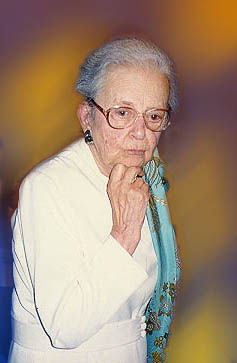 Maria
Werneck de Castro made the history of the Brazilian botanical illustration in
the second half of our century. The recognition of her work is due, mainly,
to the rigor when reproducing the details of the species and to the technical
and artistic quality of the drawings which made possible to use them for determining
the species drawn. Only the creative capacity of the artist joined to the scientific
knowledge of the botanists with whom or for whom, she worked, could result in
such a perfect work, not only of the artistic point of view but else of the
scientific point of view.
Maria
Werneck de Castro made the history of the Brazilian botanical illustration in
the second half of our century. The recognition of her work is due, mainly,
to the rigor when reproducing the details of the species and to the technical
and artistic quality of the drawings which made possible to use them for determining
the species drawn. Only the creative capacity of the artist joined to the scientific
knowledge of the botanists with whom or for whom, she worked, could result in
such a perfect work, not only of the artistic point of view but else of the
scientific point of view.
She put, graciously, her art at the service of the science.
In everything she illustrated, she was greatly worried about obtaining the highest
degree of precision and fidelity. None work reached such richness of details
and that is her great difference. Her personality, her passion for what she
did, her capacity of being always well disposed to communicate her knowledge,
influenced a new generation of Brazilian illustrations. It has been 30 years
of botanical illustration (she painted until she was 85 old), always well disposed
to guide everyone who asked for her help. Everyone asked about not only points
out the technical perfection in her work, but also emphasizes her way of being,
the way she conducted her own life, putting heart and soul in all thing she
did, her personality, her capacity of arising emotions and the force which seems
to bud from her interior, pours out in the contact with people and crystallizes
in her watercolors making the drawn species seem to be alive elements projecting
out of the paper.
She participated in exhibitions in United States (Washington
e Pennsylvania), no Japan, South Africa and Denmark and, of course, in Brazil.
She has works in some important institution like The Rachel McMasters Miller
Hunt Library (Pennsylvania), Botanical Museum of Copenhagen and National Library,
in Rio de Janeiro. In despite of the big number of exhibitions and the recognition
that her works have obtained from the botanists and illustrators, all over the
world and in Brazil, she stays almost unknown to the public, included the orchidophiles.
This fact is due to two big reasons: First of all, Maria Werneck de Castro is
extremely modest . Then she considers that her works, as well as the work of
every botanical illustrator, need to be recognized by the contents of scientific
information it can communicate, tbhe main purpose is the scientific documentation.
So it should be put at the disposal of the greater number of researchers and
not be hanged in a wall of a home. That is why she gave her work to the collection
of National Library. Nowadays, 93 years old, with unique lucidity and power
of reasoning besides her sharp criticism capacity, she tells a little about
her life in Central Plateau and in Rio de Janeiro as well as about the trips
she did around the world.
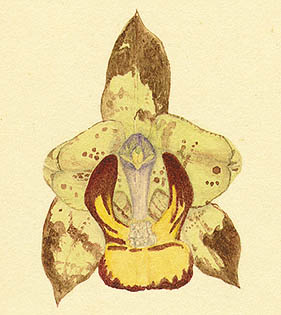 Miss Maria Werneck, how did you get interest
in botanical illustration?
Miss Maria Werneck, how did you get interest
in botanical illustration?
I worked as civil servant at Caixa Econômica Federal (governmental
bank) in Rio de Janeiro and, by the time the new capital, Brasilia, was being
built, a branch has been opened there and the manager invited me to go there.
No one wanted to go and as he knew that I loved doing everything so different,
he invited me and I accepted.
I was amazed. At the beginning, I should do a bureaucratic life which was very
hard, the lack of comfort was completely. I do not know how but, one day, I
met Ezequias Heringer who was a botanist and worked in Ministry of Agriculture,
if I am not wrong, he was studying Caparaó mountain. I handled a paper where
there was an orchid drew. He saw it and showed his interest. He was greatly
interested in orchids and, specially, fond of Cyrtopodium.
We had a good fellowship.
When did you go to Brasilia? What did you
find there?
I moved to Brasilia in January of 1960. There was nothing
but holes, wires, generators to provide light and so on. The life was tough.
One day I got home and there was no food because the house-maid did not find
anything to do. People had bought everything before her so she gave a canned
sausage with rice. I used not to eat things like that and I told her that I
should do something about that life I was leading.
So I bough a jeep. Everybody was horrified:
"- Is it possible? A civil servant of Caixa Econômica driving a jeep..."
I would like a jeep not only to go from the camping where I lived to work but
I also wanted to know the cerrado (A kind of savanna in Brazilian Central plateau).
I have never heard about cerrado or if I did, I did not pay attention, I did
not know what was it. It was during the highest pint of blooming season there.
I became almost crazy about all those flowers.
I started to drive the jeep alone, something completely crazy, I don't know
if I would do the same nowadays. I just know how to drive, if something had
happened... Then some other people got interested in going with me. Even so,
sometimes, I went alone but almost all time, there was someone with me. During
a period, no doubt about, Paschoal Carlos Magno, Secretary of Culture, used
to go with me, very often. If something happened, I didn't know what to do because
I just know how to drive, I did not anything more and Paschoal neither, he even
did not know how to drive.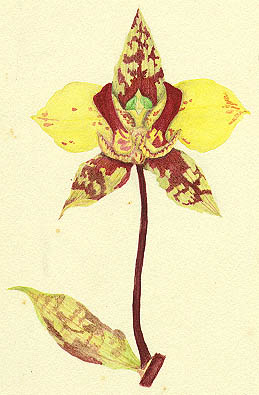 We traveled a lot around Brasilia, we have seen wonderful things in the state
of Goiás, those old cities. So I wanted to register all those things. I went
to the wood and sat on the ground for drawing.
We traveled a lot around Brasilia, we have seen wonderful things in the state
of Goiás, those old cities. So I wanted to register all those things. I went
to the wood and sat on the ground for drawing.
By this time, the roads were not still asphalted and we could see a herd of
beautiful deers running away. Even going from pilot plan to Granja do Torto
(Vice President home), we could see a herd of deers but we also saw poisonous
snakes.
So I got acquainted with the cerrado and as a result, I started to admire it.
Then I got to know the farmers around there. I went to their farmers and they
showed me thing that I have never imagined to see, tamanduá walking through
the wood (I saw one that I was fascinated), herd of ema (a kind of Brazilian
ostrich), deers. Once, I saw a very beautiful deer in the middle of a fire.
I do not know if the fire got it or if it succeeded in running away. It was
a crazy thing, driving a jeep through the fire. I was on the road but the fire
crossed from one side to another all the time. I stayed in a farmer for some
days until the fire finished. Those burnings occurred every two years. I was
sickened but the people of the region found it very natural. One day, I was
invited in a farm to lunch and ate something that I found delicious. After,
someone told me that it was tamanduá meat (from the hind-hand). It is really
a delicious meat but law forbids to kill those animals but the man does.
By this time, every one wanted to have her or his own piece of a land and a
I bought a small place. What a poesy! In this place, there was the water spring
of Prata River basin. I decided to do some kind of a shelter in order to protect
this clear water from sun rays and animals. The farmers told that this kind
of thing, only can pass through the mind of the people who come from the state
of Rio de Janeiro.
This time was very amusing, we had fun.
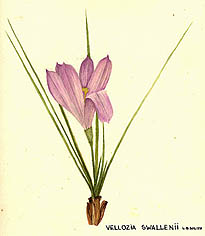
After the fire, Cyrtopodium started to bear the new shoots, what a wonderful
thing. The Cyrtopodium and Vellozia had the courage to stand the fires and the
damages made by the man. Man did not care about what were Cyrtopodiums or Vellozias.
Vellozia was used to make fire and an architect found out that when it was mixed
to the earth, they made the walls of the shanties more resistant. I saw, in
Chapada dos Veadeiros, a wood of "canela da ema" (Vellozia. The most wonderful
thing in the earth and six years later I returned and everything was destroyed.
So Mr. Heringer explained to me that, besides the man, canela da ema had another
predators like insects and an animal (I can remember which) that is fed by its
roots. The man is not its only predator. Nowadays, I know that there is nothing
in this wood.
There was not oil in the countryside. Only in the cities. In cerrado, we drove
for hours and hours and we did not find. People stored it in containers outside.
We bought the oil and filtered it in handkerchief. It had any kind of dust and
if some got into the motor, I would be completely lost.
It was a great time. The life with this jeep was very agreeable. With it, I
went to Palácio do Planalto (Government House), I went to every official place.
People were hungry. "... a civil servant Caixa Econômica driving a jeep... ".
I parked it among those rich cars. It was funny.
So, we can say that you had an adventurous
life?
I really had a great life.
Brasilia had amazing things. First there were those storms. There was nothing,
180o free of clouds, suddenly thunders and the rain dropped. There also was
the period of drought, it was a terror. The first winter I spent there, we had
4oC at night. What a coldness, what a wind, something terrible.
How did you see Brasilia when you arrived?
It should be very hard to see the nature being destroyed, shouldn't it?
The vegetation was destroyed (I am at death's door, so I can
say it), the architects did not understand anything about botanical. They pull
beautiful trees down.
I saw them ordering to fell a wonderful pequi tree (a tree of the genus Caryocar).
No matter how long I implored to preserve it, the tree was cut down. I asked
the man not to do it:
"- Please, do not do it..."
"- I do, I do, they asked me to do, so I do. The engineers will be furious if
I do not do what he asked me to do".
And he did.
Between the blocks, instead of conserving the local species, the architects
decided to plant trees from another places like Mexico. They cut down every
thing and put plants which did not come from the cerrado, everything you can
imagine but nothing from the cerrado.
So do you think, Miss Werneck, that they
could preserve the trees of the cerrado between blocks?
Of course, they wanted a flowered city and the cerrado trees
also have flowers but they did not believe on it. Even thought they would not
preserve every thing, they could maintain them, at least, between the blocks.
But they had no consciousness about it. Brazil architects by this time had no
idea what was the cerrado, Atlantic forest...
Have you met someone drawing in those ways?
Never, never. Just at the University.
How did you choice what to draw, what were
yours criterion to draw?
I saw the beauty of a tree, entirely covered with flowers,
so I drew.
And about the orchids, what was your engagement
with them?
It was little and very special. I found out that orchids can
also grow in ground. I did not know that, to me, orchids only grew on trees.
September came and the Cyrtopodiums were bearing the new shoots and I was delighted
because its budding, its growth, the entirely formation until it bears flowers
was (and still is) an extraordinary thing. Mr. Heringer encouraged my enthusiasm.
As I said, he passionately fond of Cyrtopodium which was the subject of the
intense correspondence between him and Mr. Guido Pabst who was specialized in
orchids.
One day, Mr. Heringer received a letter from Harry Blossfeld, an orchidophile,
asking him if he knew someone to send a drawing to the exhibition that will
take place in Pennsylvania (Hunt Botanical Library, Carnegie Mellon University,
Pittsburgh, USA) and he talked to me.
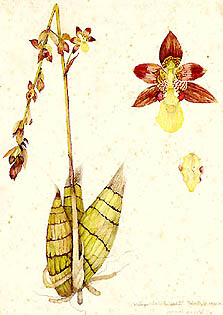 |
I had a drawing in a paper of the poorest quality
of the world, The ink I had, by chance, brought from Rio and was English
(inks and brushes) but the paper was the worst and most of all, very, very
small in such a way that it was impossible to draw the entirely plant so
I should break it. I thought it was horrible but there was no other way.
I drew Cyrtopodium completely but it was folded in the middle and this modified
the plants, didn't it? Well, the plant did not seem exactly how it was because
it was presented always divided. |
Those two drawings, Vellozia flavescens and Cyrtopodium paludicolum,
were sent by Mr. Heringer and Mr. Pabst to Pennsylvania. The director wrote me
asking if I would sell them. I, of course, became radiant and, at the same time,
astonished as I could never give any value to those pieces painted in so inferior
quality paper.
So in the botanical fields, you were more attached to Mr. Pabst and Mr. Heringer. Have you ever met Guido Pabst?
Yes, I did. He was such a charming person. He corresponded with
me, working in the way he worked, he found time to write me. Once, I sent him
a drawing of a Cyrtopodium because I thought, I do not know why, that it was the
same that appeared in Lund's study, about Lagoa Santa. He agreed with me but to
be sure, he considered he should go to the herbarium in Amsterdam (If I am not
wrong) and this, a Brazilian botanist could not do. Going so far just for studying
a Cyrtopodium... Once, Guido Pabst gave me a Hoehne's book to look for a Cyrtopodium
and I found one that seemed to me to be the same I drew, however, I was, I still
am ignorant in Botanical. So things I used to say, I only could say to Mr. Pabst
e Mr. Heringer and to no one more.
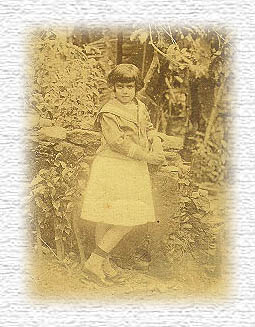 Did you start to draw during the period you lived in the state of Santa Catarina?
Did you start to draw during the period you lived in the state of Santa Catarina?
No, there, it was just school drawings. But very young, I began
to learn drawing with crayon conté.
Where are you born?
I came from Vassouras, state of Rio de Janeiro and were born
in 1905.
You said that you started with botanical illustrations when you moved to Brasilia, in l960. So you got interest in this kind of drawing when you were 55 years old, what kind of drawing did you do before?
Here, in Rio, I did anatomical illustration but I gave up completely
to do botanical illustration, something that I have never thought about...
And anatomical illustration, how did it appear in your life, what was the purpose?
I had a friend who was a doctor and knowing that I loved drawing,
she asked me why not to go Santa Casa de Misericórdia (Hospital for poor people).
She brought me there and I met Raymundo Honório who would be my teacher. So I
started to draw pathological anatomy for scientific documentation.
My brother almost died when I brought the trays home, he looked inside and saw
a lung, he became furious. The turned back and told:
"- That your mania..."
I was present during the surgeries. My life was great, a very rich life.
I do not see any influence in your work, it seems to be you have delineated your way by yourself.
There was no one drawing with me, only Raymundo, my teacher.
He was a great drawer for pathological anatomy, he did the drawings for famous
scientists as Oswaldo Cruz, Carlos Chagas, Adolfo Lutz. He draw other things but
not botanical works.
Nowadays, every thing is photographed but it is not the same. The texture of the
subject is lost in the photo.
In Brasilia, due to your work, you just drew during the week-end. You spent every week-end doing this?
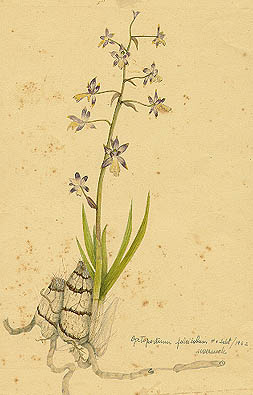 No,
I should promenade. Whenever Paschoal had time or wanted, we went for a stroll,
just for looking around.
No,
I should promenade. Whenever Paschoal had time or wanted, we went for a stroll,
just for looking around.
I did everything I could but I did not have much time. I just have Saturday and
Sunday. During the week, I should work at Novacap and this job had nothing with
my activities as an illustrator. There was else that deficiency of paper. There
was a funny thing, I did not consider that those drawing had enough value to be
conserved.
My former teacher of pathological anatomy, Ryamundo Honório, when he saw the Cyrtopodium
I have drew in such paper, told me:
"-You have got a miracle. Drawing a plant, in this way, in a so inferior quality
paper!".
And after this period in Brasilia?
I retired, stayed there for a while and then I came back. Here,
in Rio de Janeiro, I did much more botanical illustrations than I did in cerrado.
And all those drawings you did, where are
they?
The Hunt Botanical Library brought those two drawings I have
already told about, another one is the Botanical Garden of Copenhagen. National
Library, in Rio de Janeiro, keeps a big part of my works. There are some of them
with Pedro Carauta, FEEMA. The original plates for pressing the stamps are in
Brasilia, at ECT (Brazilian Post Office). And the some drawings about the cerrado
are with someone else in Rio de Janeiro. There is more thing spread around.
 Maria
Werneck de Castro made the history of the Brazilian botanical illustration in
the second half of our century. The recognition of her work is due, mainly,
to the rigor when reproducing the details of the species and to the technical
and artistic quality of the drawings which made possible to use them for determining
the species drawn. Only the creative capacity of the artist joined to the scientific
knowledge of the botanists with whom or for whom, she worked, could result in
such a perfect work, not only of the artistic point of view but else of the
scientific point of view.
Maria
Werneck de Castro made the history of the Brazilian botanical illustration in
the second half of our century. The recognition of her work is due, mainly,
to the rigor when reproducing the details of the species and to the technical
and artistic quality of the drawings which made possible to use them for determining
the species drawn. Only the creative capacity of the artist joined to the scientific
knowledge of the botanists with whom or for whom, she worked, could result in
such a perfect work, not only of the artistic point of view but else of the
scientific point of view. 
 Miss Maria Werneck, how did you get interest
in botanical illustration?
Miss Maria Werneck, how did you get interest
in botanical illustration?  We traveled a lot around Brasilia, we have seen wonderful things in the state
of Goiás, those old cities. So I wanted to register all those things. I went
to the wood and sat on the ground for drawing.
We traveled a lot around Brasilia, we have seen wonderful things in the state
of Goiás, those old cities. So I wanted to register all those things. I went
to the wood and sat on the ground for drawing. 

 Did you start to draw during the period you lived in the state of Santa Catarina?
Did you start to draw during the period you lived in the state of Santa Catarina?
 No,
I should promenade. Whenever Paschoal had time or wanted, we went for a stroll,
just for looking around.
No,
I should promenade. Whenever Paschoal had time or wanted, we went for a stroll,
just for looking around. 